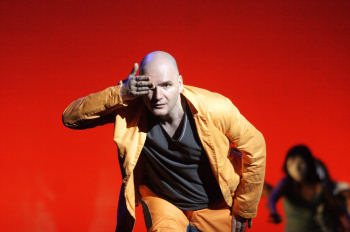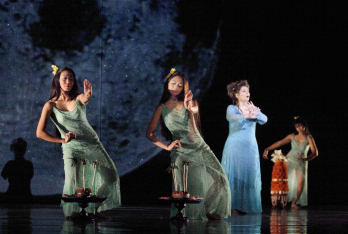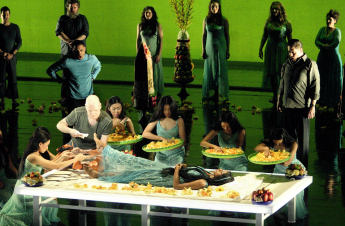Monteverdi, Orfeo: English
National Opera, 15.4.2006 (ME)

‘L’Orfeo’ was not the first
opera, that honour belonging to Peri and Corsi’s
Daphne of 1598, but it was Monteverdi’s
first opera and certainly the first ‘great’
work in that genre. When it was premiered at the ducal
palace in Mantua in 1607, the composer used a small
cast of around nine or ten singers, ideal for such
an intimate space and for the depiction of such deeply
personal emotions as love and loss: the composer’s
own wife, the court singer Claudia Cattaneo, died
in the same year. Today Orfeo occupies a central
place in the repertoire: ENO’s last new production
was in 1981, with Anthony Rolfe Johnson in the title
role – that was a fairly conventional affair,
classically restrained in style, very different to
this latest one by the modish Chinese-American Chen
Shi-Zheng, in collaboration with the Handel and Haydn
Society of Boston.

Monteverdi’s most remarkable legacy was surely
his invention of the stile concitato, or ‘agitated
style,’ a form of musical expression designed
to give voice to extreme emotions which he perfected
in the later Il Combattimento di Tancredi e Clorinda,
and this version of Orfeo served more than
anything else to remind us of how original that concept
was: it was not so much the stage pictures as the
sound world which Lawrence Cummings, the orchestra
and singers had created, which made for a genuinely
thrilling evening. The regular ENO orchestra joined
forces with the Orchestra of the Age of Enlightenment,
and they were performing from an edition of the score
based on facsimiles of 1609 and 1615: instruments
used included historical copies, tremendous attention
had been given to the detail of Monteverdi’s
singing style, and, as the conductor says, this enabled
‘the intonation and sound world of the seventeenth
century’ to be ‘absorbed as if by osmosis.’
It is not easy to transpose that which was created
for a private space into something suitable for the
vast cavern that is the Coliseum, but it is a tribute
to Cummings and most of the singers that one was seldom
conscious of the disparity. Such is the virtuosity
required of the singer of the title part that few
singers are up to it unless you are willing to pretend
that a pared-down or otherwise adapted version of
the role is acceptable: there is of course a lot of
that about, but if what you are seeking is no-holds-barred
virtuosity coupled with a willingness to throw himself
into whatever the director has decreed – or,
putting it bluntly, the ability to do idiotic things
with the body whilst doing glorious ones with the
voice – then John Mark Ainsley is your one stop
shop. His voice is not large, being far more suited
to a space such as a room in a ducal palace than a
1500 seat opera house, but then the role itself is
not in the big bow-wow style.
I question the notions that Orpheus must be ‘sent
up,’ that he is some sort of pop idol with a
grievance, and that he should ascend to the skies
in quite so mundane a manner (harnessed like an aid
parcel of rice travelling in the opposite direction)
but given all that, you could just shut your eyes
and listen to some of the most agile, daring and expressive
singing anyone could hope to hear. I have previously
described the aria ‘Possente Spirito’
as the most taxing nine minutes of any singer’s
life, but Ainsley makes it sound as natural as such
complex music can be: when Caronte falls asleep you
are persuaded, not that Orfeo has bored him into slumber
but that he has fallen into a strategic doze so that
the poet-singer can cross the river and achieve his
desire. Ainsley is less convincing in his final scenes,
perhaps because the production makes too much of his
character’s egotism and self-dramatization,
but elsewhere he is peerless, whether joyful in the
ecstatic music of the first act or numbed by grief
in ‘Tu se’ morta, se’ morta, mia
vita.’
He is supported by a very fine, mostly young cast:
Elizabeth Watts sang with crystalline clarity as Music,
although the part of Hope lies a little low for her;
Wendy Dawn Thompson was a wonderful Messenger, dignified
in her sorrow and conveying every nuance of her doleful
story – both these singers are ex students of
the RCM and it is good to see them on the ENO stage,
reminding us not only that the RCM continues to provide
singers of outstanding talent, but also that our national
opera company is fulfilling its role in terms of nurturing
them. Tom Randle was a supportive ensemble member
as well as a noble Apollo, if a times a little underpowered;
Stephanie Marshall was a finely seductive Proserpina,
Jeremy White an unctuous Pluto, and Brindley Sherratt
a finely characterized Charon. Ruby Philogene seemed
over-parted as Eurydice. There was much fine singing
from the ensemble (more usually referred to as ‘shepherds’)
with Tim Mead and Toby Stafford-Allen being especially
noteworthy.

There was much to like about the production, although
those who saw Trisha Brown’s version in Brussels
might not find this one particularly original, since
not only the basic set but the use of gesture, movement
and dance were very similar. The lighting, by Scott
Zielinski, is wonderful: subtle, exciting and wonderfully
varied, his designs create worlds of murky darkness
suggestive of mysterious other realms, or of glorious
colour-filled spring and summer fields. Much of the
stage design, too, is finely done, with Charon’s
deathly ferryboat being especially evocative: the
director revealed his own fascination with death and
funerals in a recent interview, and this is very intimately
shown not only in that scene but in the rituals surrounding
Euridice.
Where I part company from this director is his use
of so many dancers, and his apparent idea that the
world of Western celebration must be suggested by
– yet again – youths in T shirts swigging
from bottles of Bolly: that sort of thing is so RSC
circa 1989, and it does nothing to further the drama.
The dancers are all graceful, beautiful and elegant,
but they seem to be used as eye candy rather than
integrated into the whole; my own taste in such things
is to let the music speak for itself through the singers,
rather than being given the impression that we are
unable to sit and listen to singing – we must
somehow have vibrant colours flashing before our eyes.
I found the scene between Orfeo and Apollo to be lacking
in dignity, although of course the singing compensated
for much. As you might expect, I loathed the penny-
plain, deeply unpoetic translation.
Orfeo has not lost its power to move us, and
when it is sung and played like this, in a production
which, however much I might question some elements,
is redolent of deep love for, and commitment to the
work, it cannot fail to remind us of the power of
great music to change our perceptions. It was a joy
to hear the quality of playing which Cummings obtained
from the orchestra, especially from the lutes, recorders
and trumpets, although what a shame it was that two
ladies sitting near to me, and obviously connected
to the production or the house in some way, so they
should have known better, felt it necessary to continue
their ‘mwah mwah’ socializing during the
opening fanfare, as though it were a mere piece of
background music. There was clearly a big ‘fan
club’ presence for the director, to judge by
the roars he received when he took his bow –
significantly, he occupied the central position in
the ‘line-up,’ whilst the singers –
even Orfeo himself – took a modest side part.
The ascendancy of the director being made manifest?
I hope not, since this above all is an opera which
depends upon the strength of its singing, and it is
in that area which this version of it is most obviously
successful.
Melanie Eskenazi

